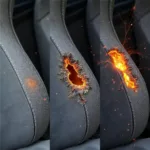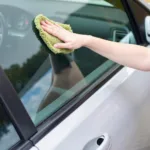Dealing with a broken or malfunctioning car window can be a real pain. Whether it’s a shattered window from a break-in, a window that won’t roll up, or a mysterious rattling sound, car window problems can be both inconvenient and stressful. Fortunately, understanding the common issues, repair options, and associated costs can help you navigate the process smoothly and get back on the road with confidence.
Common Car Window Problems and Their Causes
Car windows, despite their simple appearance, are intricate systems with various components that can malfunction. Identifying the root cause of your car window woes is crucial for determining the appropriate repair strategy. Here’s a breakdown of common car window problems and their potential culprits:
1. Window Won’t Roll Up or Down
-
Faulty Window Regulator: The regulator is a mechanism that lifts and lowers the window. Over time, the cables or gears within the regulator can wear out, leading to sluggish movement or complete failure.
-
Malfunctioning Window Switch: The switch on your car door that controls the window can wear out or short-circuit, preventing the window from responding.
-
Blown Fuse: A blown fuse in your car’s electrical system can disrupt power to the window motor, rendering it inoperable.
2. Window Glass Off Track
-
Worn-Out Window Guides: The window glides along a track when it’s raised or lowered. If these guides wear down or become misaligned, the window can come off track, making it difficult or impossible to operate.
-
Damaged Window Seals: Rubber seals around the window provide a secure fit and prevent water leaks. Deteriorated seals can cause the window to shift, increasing the likelihood of it coming off track.
3. Slow Window Movement
-
Failing Window Motor: The motor provides the power to move the window up and down. A failing motor might struggle to lift the window, resulting in slow or sluggish movement.
-
Obstructed Window Track: Dirt, debris, or foreign objects lodged in the window track can create friction, hindering the window’s smooth operation.
4. Broken or Shattered Window Glass
-
Impact from Accidents or Vandalism: Car accidents or attempted break-ins can result in broken or shattered window glass, compromising both security and safety.
-
Extreme Temperature Changes: In rare cases, rapid temperature fluctuations can cause stress on the glass, leading to cracks or even shattering.
Car Window Repair Options
Now that you have a better understanding of potential car window problems, let’s delve into the available repair options:
1. DIY Repairs: A Viable Option?
While some minor car window issues might seem like simple DIY projects, it’s crucial to approach them with caution. Attempting complex repairs without the necessary expertise and tools can exacerbate the problem or even lead to injury.
2. Seeking Professional Car Window Repair
In most cases, seeking professional car window repair is the safest and most reliable course of action. Qualified technicians possess the knowledge, experience, and specialized tools to diagnose and address car window issues effectively.
Car Window Repair Costs: What to Expect
The cost of car window repair can vary significantly depending on factors such as the extent of damage, the type of vehicle, and the location of the repair shop. Here’s a general breakdown:
- Window Regulator Replacement: $150 – $400
- Window Motor Replacement: $120 – $300
- Window Switch Replacement: $50 – $200
- Window Glass Replacement: $200 – $500 (or more for specialized or luxury vehicles)
It’s essential to request quotes from multiple repair shops to compare prices and services. Remember that opting for the cheapest option isn’t always the best approach, as quality and expertise can influence the longevity and effectiveness of the repair.
Preventing Future Car Window Problems
Taking preventative measures can significantly reduce the likelihood of encountering car window issues in the future. Consider these tips:
-
Regularly clean the window tracks and seals: Remove dirt, debris, and build-up to ensure smooth window operation.
-
Lubricate the window tracks: Apply a silicone-based lubricant to minimize friction and prevent wear and tear.
-
Be mindful when using power windows: Avoid forcing the window if it encounters resistance.
-
Address any signs of damage promptly: Ignoring minor issues can lead to more significant problems down the line.
Conclusion
Car window problems, while frustrating, are a common occurrence. Understanding the potential causes, repair options, and associated costs empowers you to make informed decisions. Remember, prioritizing regular maintenance and seeking professional help when necessary are key to keeping your car windows in optimal condition and ensuring a safe and comfortable driving experience.
FAQs
1. Can I drive my car with a cracked window?
Driving with a cracked window compromises the structural integrity of the glass and increases the risk of the crack spreading. It’s best to get it repaired as soon as possible.
2. How long does it take to replace a car window?
The replacement time depends on the severity of the damage and the availability of parts, but it typically takes a few hours.
3. Does car insurance cover window repair?
Coverage varies depending on your insurance policy. Comprehensive coverage typically includes window repair or replacement for damage caused by events other than collisions, such as vandalism or theft.
4. How do I know if my window regulator is broken?
Common signs of a broken window regulator include a window that won’t go up or down, strange noises when operating the window, and a window that falls into the door.
5. Can I tint my car windows after repair?
Yes, you can typically tint your car windows after repair, but it’s essential to check local regulations regarding window tint darkness.
Need Help with Car Window Repair?
Get in touch with us! We’re here to answer your questions and provide expert assistance. Contact us via WhatsApp at +1(641)206-8880 or email us at [email protected]. Our dedicated customer support team is available 24/7 to assist you.


